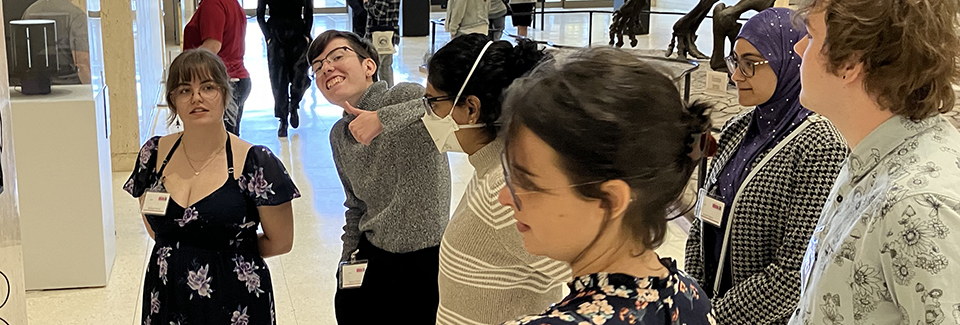The opportunity to showcase the work created in the lab was exciting, and creating artwork specifically for that exhibition became one of the goals of the lab's activities. The preparation of pieces for the exhibition was divided into two groups: one special research group featuring five undergraduate students and one selected piece from the Experimental Animation course international collaboration.
The focused research group was mainly inspired by Paul Wells and Johnny Hardstaff's book Re-Imagining Animation: The Changing Face of the Moving Image (2008) and their chapter, "Re-Animating Pedagogy." I adapted their Object React activity for the participants in my lab. Working with the curators from the TTU Museum, we requested them to select three to ten of the most iconic items in their collection. We received a list of items from anthropology, art, clothing, textiles, and natural history. Those items from the museum were presented to the students, and three of them chose to work on pieces inspired by the museum's collection: the bumblebee and fiery searcher or calosoma scrutator from the natural history collection, and a 19th century Ball gown, from the clothing and textile collection. Each project was uniquely conceived for this exhibition. The main criteria were that their production had to focus on material processes, be related to Texas, or be inspired by early animation devices, such as the flipbook, the phenakistiscope, or even the barrier-grid animation, also known as ombro cinema.
Mickey Dolphin's Fiery Searcher in the Leaves employs a crafted kaleidoscope to enhance the animation of a paper cutout beetle, offering a captivating and multifaceted viewing experience.
A display loops the animation of a paper cutout beetle that changes in scale when seen through the kaleidoscope accompanying the piece.
Eesha Muddasani's Bee Phenakistiscope piece combines paper cut-out animation with a phenakistiscope to create an animated shadow. The intricacy of Muddasani's lacy design comes to life when the device spins, and a powerful source of light shines through the slits of her device when placed in a dark environment.

Katherine Norris' Garden Knock animation featuring a needle-felted puppet of an opossum in a ball gown, challenges the status quo by placing aristocratic clothing on a marsupial traditionally thought of as dirty. Possums are also known for playing dead in response to fear, so Norris's protagonist, Daisy, has difficulty hiding her wild nature while trying to maintain her maiden demeanor.
Zarah Najmi's Mocking Bird Family Portrait presents a hands-on experience through three flipbookit boxes—technology inspired by the mutoscope rotating structure that builds on the flipbook animation tradition. Each box showcases a looping animation representing a family of mockingbirds, with the highlight being the interactive feature of the mother bird's animated wings.
Nick Mahoney's Hummingbird Travels West creatively utilizes the barrier-grid animation technique to depict a journey from Dallas to Lubbock. The public is engaged in manually animating the artwork and experiencing an animated optical illusion. This barrier-grid animation has evolved into lenticular animation technology and offers a surprising way to animate within one image.
A test exhibition at our school was a major component of the preparation for the show. Considering how people interact with the work and how its display can be optimized was crucial for the pieces' success. The exhibition includes the collaborative project Roundtrip Animation, which involved animation students from Brussels and Dallas. Inspired by autumnal and Halloween themes, their animations are showcased alongside interactive phenakistiscopes. This project uses software and phenakistiscopes to explore the mix of old and new media as part of our experimental media archeology investigation.
These works resulted from experimentation and went through many iterations in a pedagogical context. They greatly impacted students by encouraging them to embrace interdisciplinary inquiry. By actively preparing the exhibits, the students developed problem-solving skills, learned to accept and give feedback more easily, and developed their creative potential by testing and prototyping to optimize their exhibits. This resulted in the creation of artworks that made a dynamic contribution to the exhibition Animation as Art: A Multi-Sensory Experience, while offering students the opportunity of having a museum exhibition on their curriculum with well-established artists and experimental animators as their peers in the show.
Co-Curator of the exhibition "Animation as Art: A Multi-Sensory Experience"

